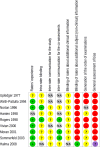Reliability of Diagnosis and Clinical Efficacy of Cranial Osteopathy: A Systematic Review
- PMID: 27936211
- PMCID: PMC5147986
- DOI: 10.1371/journal.pone.0167823
Reliability of Diagnosis and Clinical Efficacy of Cranial Osteopathy: A Systematic Review
Abstract
Context: In 2010, the World Health Organization released benchmarks for training in osteopathy in which they considered cranial osteopathy as an important osteopathic skill. However, the evidence supporting the reliability of diagnosis and the efficacy of treatment in this field appears scientifically weak and inconsistent.
Objectives: To identify and critically evaluate the scientific literature dealing with the reliability of diagnosis and the clinical efficacy of techniques and therapeutic strategies used in cranial osteopathy.
Methods: Relevant keywords were used to search the electronic databases MEDLINE, PEDro, OSTMED.DR, Cochrane Library, and in Google Scholar, Journal of American Osteopathy Association and International Journal of Osteopathic Medicine websites. Searches were conducted up to end June 2016 with no date restriction as to when the studies were completed. As a complementary approach we explored the bibliography of included articles and consulted available previous reviews dealing with this topic.
Study selection: Regarding diagnostic processes in cranial osteopathy, we analyzed studies that compared the results obtained by at least two examiners or by the same examiner on at least two occasions. For efficacy studies, only randomized-controlled-trials or crossover-studies were eligible. We excluded articles that were not in English or French, and for which the full-text version was not openly available. We also excluded studies with unsuitable study design, in which there was no clear indication of the use of techniques or therapeutic strategies concerning the cranial field, looked at combined treatments, used a non-human examiner and subjects or used healthy subjects for efficacy studies. There was no restriction regarding the type of disease.
Search results: In our electronic search we found 1280 references concerning reliability of diagnosis studies plus four references via our complementary strategy. Based on the title 18 articles were selected for analysis. Nine were retained after applying our exclusion criteria. Regarding efficacy, we extracted 556 references from the databases plus 14 references through our complementary strategy. Based on the title 46 articles were selected. Thirty two articles were not retained on the grounds of our exclusion criteria.
Data extraction and analysis: Risk of bias in reliability studies was assessed using a modified version of the quality appraisal tool for studies of diagnostic reliability. The methodological quality of the efficacy studies was assessed using the Cochrane risk of bias tool. Two screeners conducted these analyses.
Results: For reliability studies, our analysis leads us to conclude that the diagnostic procedures used in cranial osteopathy are unreliable in many ways. For efficacy studies, the Cochrane risk of bias tool we used shows that 2 studies had a high risk of bias, 9 were rated as having major doubt regarding risk of bias and 3 had a low risk of bias. In the 3 studies with a low risk of bias alternative interpretations of the results, such as a non-specific effect of treatment, were not considered.
Conclusion: Our results demonstrate, consistently with those of previous reviews, that methodologically strong evidence on the reliability of diagnostic procedures and the efficacy of techniques and therapeutic strategies in cranial osteopathy is almost non-existent.
Conflict of interest statement
The authors have declared that no competing interests exist.
Figures






References
-
- Still AT. Autobiography of Andrew T. Still, with a history of the discovery and development of the science of osteopathy, together with an account of the founding of the American school of osteopathy. 1897. Available: http://archive.org/details/autobiographyand00stiliala.
-
- WHO. Benchmarks for training in traditional / complementary and alternative medicine. World Health Organization. 2010. Available: http://www.who.int/medicines/areas/traditional/BenchmarksforTraininginOs....
-
- Wilkinson J, Thomas KJ, Freeman JV, McKenna B. Day-to-day practice of osteopaths using osteopathy in the cranial field, who are affiliated with the Sutherland Cranial College of Osteopathy (SCCO): A national survey by means of a standardised data collection tool. Int J Osteopath Med. 2015. March;18(1):13–21.
-
- Decree of 25 March 2007 on the osteopathic training, the accreditation commission for training institutions and derogations, 43 Article 3. Sect. 3, p. 5687.Available: https://www.legifrance.gouv.fr/affichTexte.do?cidTexte=JORFTEXT000000273294
Publication types
MeSH terms
LinkOut - more resources
Full Text Sources
Other Literature Sources
Medical
Research Materials

